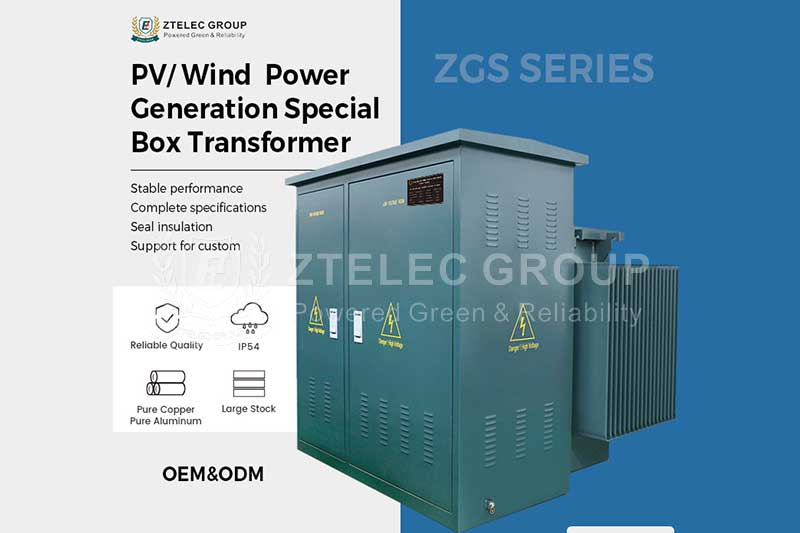What protections measures should be configured for dry-type transformers?
Time:2025-01-27 Auther:ZTelec-www.ztelectransformer.com
As an important equipment in the power system, the safe and stable operation of dry-type transformers is crucial to the reliability of the entire power system. In order to ensure the normal operation of dry-type transformers and prevent potential failures, a series of protection measures need to be configured.

Protection measures that should be configured for dry-type transformers
1. Overcurrent protection
Overcurrent protection is one of the most basic protections for dry-type transformers. When an overcurrent occurs in the transformer, the overcurrent protection device will act quickly to cut off the fault current and prevent equipment damage. Overcurrent protection is generally divided into instantaneous overcurrent protection and timed overcurrent protection. Instantaneous overcurrent protection is used to protect equipment from the impact of instantaneous large currents, while timed overcurrent protection is used to protect equipment from long-term overcurrent damage.
2. Differential protection
Differential protection is one of the most commonly used protections for dry-type transformers. It detects whether a fault occurs inside the equipment by comparing the difference between the currents on the high and low voltage sides of the transformer. When a short circuit, grounding or loop imbalance occurs inside the transformer, the differential protection can quickly cut off the fault current and protect the equipment from damage. The differential protection has high sensitivity and fast action speed and is one of the important protections to ensure the safe operation of dry-type transformers.
3. Grounding protection
For forced grounding dry-type transformers, neutral point grounding is an important measure to protect the safety of personnel and equipment. Grounding protection can detect neutral point grounding faults and cut off the fault current to prevent electric shock and equipment damage. When configuring grounding protection, ensure that the grounding resistance meets the requirements to improve the reliability of protection.

4. Winding temperature protection
Excessive winding temperature of dry-type transformers may cause equipment damage. Therefore, winding temperature protection is required to monitor the winding temperature and take timely measures. Winding temperature protection usually installs the winding temperature sensor inside the transformer, controls the relay action according to the temperature change, and protects the equipment. When the winding temperature exceeds the set value, the protection device will issue an alarm signal or cut off the power supply to prevent the equipment from overheating and damage.
5. Overvoltage protection and undervoltage protection
Overvoltage protection is used to prevent the transformer from being damaged by the impact of excessively high voltage. When the system voltage exceeds the rated voltage of the transformer, the overvoltage protection device will operate to cut off the power supply or reduce the voltage to protect the equipment. Undervoltage protection is used to prevent the system voltage from being too low and causing the transformer to fail to work properly. When the system voltage is lower than a certain proportion of the rated voltage, the undervoltage protection device will issue an alarm signal or cut off the power supply.
6. Leakage protection
Leakage protection is used to detect whether there is leakage in the transformer. When leakage occurs in the transformer, the leakage protection device will act quickly to cut off the fault current and prevent accidents such as electric shock and fire. Leakage protection is one of the important measures to ensure personnel safety and equipment safety.
7. Shell protection
Although shell protection does not belong to the category of electrical protection, it is equally important for the safe operation of dry-type transformers. Dry-type transformers can use different shells according to environmental characteristics and protection requirements. For example, the IP20 protective shell can prevent the entry of solid foreign objects with a diameter greater than 12mm, providing a safety barrier for live parts; the IP23 protective shell, in addition to the protection function of IP20, can also prevent water droplets from entering within 60° of the vertical line. Choosing a suitable shell can improve the protection level of the dry-type transformer and reduce the probability of failure.
The basic principle of dry-type transformer protection configuration is to ensure that the equipment can be protected in a timely and effective manner under various working conditions. And it can prevent the expansion of faults, and ensure the safe operation of the power system. These protection measures should comply with relevant standards and specifications. And these protection measures should be reasonably selected according to the specific characteristics of the dry-type transformer and the operating environment.



